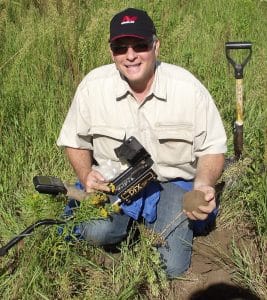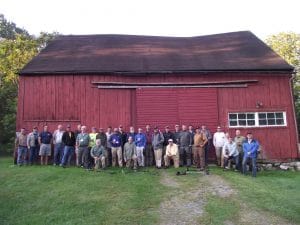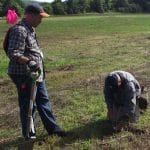Not too long ago, archeologists thought of metal detectors as a evil tool, used only by looters. Some still think this way. However, many are coming to see them as a useful tool, if used in the right way. The Modern Heritage Foundation supports a workshop series called
“Advanced Metal Detecting for the Archeologist,” or AMDA. These workshops take place across the country, and offer training to archeologists in using metal detectors in the right way. I spent last weekend at the AMDA workshop in at the Bennington battlefield (1777), in New York.
The Workshop
The workshop took three days. The first was a classroom day, with lectures on how to metal detect, how to work systematically with a metal detector, and what kinds of sites metal detectors work on. Most people think of battlefields, and they do work well there. They also are great for outlining historic homesteads, blacksmith shops, and other metal-rich sites. Metal detectors even work on precontact sites, as they can be used to find things like hearths, which are magnetic. That takes some skill, honestly, but it has been done.
We spent the other two days in the field. Literally. It was the field where the Americans and British fought, and where the British surrendered (woot!). We laid out long rows of masonry string, then carefully swept down each. Two students worked with each instructor, who made sure we did things right and didn’t miss anything. We learned how to read and listen to the different kinds of machines to know what kinds of things they were finding.
The Finds
What did we find? Well, a lot of things.

AMDA volunteer showing the six-pound British cannonball discovered during the project (image courtesy of Chris Espenshade)
Many hits turned out to be nails, suggesting there had been a house nearby. With time, the participants developed an ear for the way the detector chirped, and could generally guess when something was going to be a piece of iron (there were a lot of nails). Not all of those pieces of iron were small and insignificant (read: nails), though. One participant dug a large iron hit that turned out to be a six-pound British cannonball! Also, we found musket balls from several different guns and a few buttons and sleeve links (think of a cuff link, but older) from soldiers’ uniforms.
An Arkansan Abroad
So, why did the Survey send me up there? Several reasons. First, I am interested in working more closely with AMDA in the future, and before you can be an instructor, you have to take the class.
We are very interested in hosting one of these workshops here in Arkansas, probably on one of the Camden Expedition battlefields from 1864. Seeing how they work will help with planning that workshop in the next few years. Second, next summer’s University of Arkansas field school and Arkansas Archeological Society training program are likely going to be at Pea Ridge National Military Park, near Bentonville, and will include training in systematic metal detection. Taking this workshop will help with organizing that training, as well.
— Carl G. Drexler, Station Archeologist


